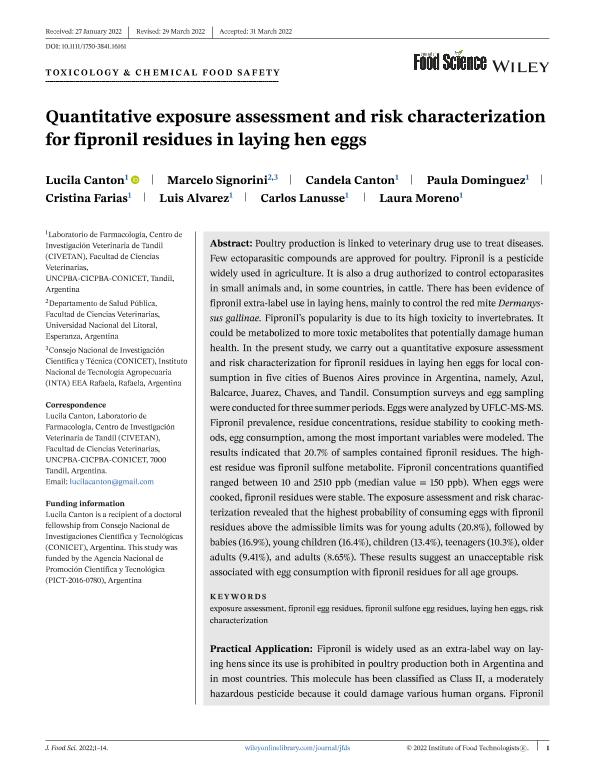Artículo
Quantitative exposure assessment and risk characterization for fipronil residues in laying hen eggs
Cantón, Lucila ; Signorini, Marcelo; Cantón, Candela
; Signorini, Marcelo; Cantón, Candela ; Dominguez, Maria Paula
; Dominguez, Maria Paula ; Farias, Cristina Elena
; Farias, Cristina Elena ; Alvarez, Luis Ignacio
; Alvarez, Luis Ignacio ; Lanusse, Carlos Edmundo
; Lanusse, Carlos Edmundo ; Moreno Torrejon, Laura
; Moreno Torrejon, Laura
 ; Signorini, Marcelo; Cantón, Candela
; Signorini, Marcelo; Cantón, Candela ; Dominguez, Maria Paula
; Dominguez, Maria Paula ; Farias, Cristina Elena
; Farias, Cristina Elena ; Alvarez, Luis Ignacio
; Alvarez, Luis Ignacio ; Lanusse, Carlos Edmundo
; Lanusse, Carlos Edmundo ; Moreno Torrejon, Laura
; Moreno Torrejon, Laura
Fecha de publicación:
05/2022
Editorial:
Wiley Blackwell Publishing, Inc
Revista:
Journal of Food Science
ISSN:
0022-1147
Idioma:
Inglés
Tipo de recurso:
Artículo publicado
Clasificación temática:
Resumen
Poultry production is linked to veterinary drug use to treat diseases. Few ectoparasitic compounds are approved for poultry. Fipronil is a pesticide widely used in agriculture. It is also a drug authorized to control ectoparasites in small animals and, in some countries, in cattle. There has been evidence of fipronil extra-label use in laying hens, mainly to control the red mite Dermanyssus gallinae. Fipronil's popularity is due to its high toxicity to invertebrates. It could be metabolized to more toxic metabolites that potentially damage human health. In the present study, we carry out a quantitative exposure assessment and risk characterization for fipronil residues in laying hen eggs for local consumption in five cities of Buenos Aires province in Argentina, namely, Azul, Balcarce, Juarez, Chaves, and Tandil. Consumption surveys and egg sampling were conducted for three summer periods. Eggs were analyzed by UFLC-MS-MS. Fipronil prevalence, residue concentrations, residue stability to cooking methods, egg consumption, among the most important variables were modeled. The results indicated that 20.7% of samples contained fipronil residues. The highest residue was fipronil sulfone metabolite. Fipronil concentrations quantified ranged between 10 and 2510 ppb (median value = 150 ppb). When eggs were cooked, fipronil residues were stable. The exposure assessment and risk characterization revealed that the highest probability of consuming eggs with fipronil residues above the admissible limits was for young adults (20.8%), followed by babies (16.9%), young children (16.4%), children (13.4%), teenagers (10.3%), older adults (9.41%), and adults (8.65%). These results suggest an unacceptable risk associated with egg consumption with fipronil residues for all age groups. Practical Application: Fipronil is widely used as an extra-label way on laying hens since its use is prohibited in poultry production both in Argentina and in most countries. This molecule has been classified as Class II, a moderately hazardous pesticide because it could damage various human organs. Fipronil residues in eggs could be one of the exposure pathways for consumers. Monitoring residual levels and carrying out the health risk assessment in eggs are thus in an urge.
Archivos asociados
Licencia
Identificadores
Colecciones
Articulos(CIVETAN)
Articulos de CENTRO DE INVESTIGACION VETERINARIA DE TANDIL
Articulos de CENTRO DE INVESTIGACION VETERINARIA DE TANDIL
Citación
Cantón, Lucila; Signorini, Marcelo; Cantón, Candela; Dominguez, Maria Paula; Farias, Cristina Elena; et al.; Quantitative exposure assessment and risk characterization for fipronil residues in laying hen eggs; Wiley Blackwell Publishing, Inc; Journal of Food Science; 87; 6; 5-2022; 2775-2788
Compartir
Altmétricas



